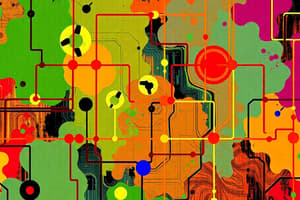Podcast
Questions and Answers
What is the formula to determine the total resistance of a series circuit comprising two resistors?
What is the formula to determine the total resistance of a series circuit comprising two resistors?
- $RT = V1 + V2$
- $RT = R1 + R2$ (correct)
- $\frac{1}{RT} = \frac{1}{R1} + \frac{1}{R2}$
- $RT = R1 \times R2$
Which characteristic is true for a parallel circuit?
Which characteristic is true for a parallel circuit?
- Supply voltage is equal to the sum of all voltages across branches.
- Supply voltage is the same as all branch voltages. (correct)
- Total resistance is higher than the highest individual resistance.
- Total current is the same across all branches.
Which of the following statements is true regarding series-parallel circuits?
Which of the following statements is true regarding series-parallel circuits?
- They have no specific characteristics.
- They combine characteristics of both series and parallel circuits. (correct)
- They only exhibit characteristics of series circuits.
- They only exhibit characteristics of parallel circuits.
How is the total current calculated in a parallel circuit?
How is the total current calculated in a parallel circuit?
What happens to the total resistance when two resistors are connected in parallel?
What happens to the total resistance when two resistors are connected in parallel?
What is the total resistance of two resistors of 50 Ω and 70 Ω connected in series with a 100 V supply?
What is the total resistance of two resistors of 50 Ω and 70 Ω connected in series with a 100 V supply?
What is the supply current when a 100 V supply is connected to a total resistance of 120 Ω?
What is the supply current when a 100 V supply is connected to a total resistance of 120 Ω?
If the current drawn from a 110 V supply through a resistor R2 is 0.5 A and R1 is 100 Ω, what is the value of R2?
If the current drawn from a 110 V supply through a resistor R2 is 0.5 A and R1 is 100 Ω, what is the value of R2?
What voltage is across resistor R1 if the current through R1 is 0.2 A and its resistance is 80 Ω?
What voltage is across resistor R1 if the current through R1 is 0.2 A and its resistance is 80 Ω?
What is the current flowing through a circuit if the total resistance is 240 Ω and the supply voltage is 120 V?
What is the current flowing through a circuit if the total resistance is 240 Ω and the supply voltage is 120 V?
What is the total resistance RT in a series circuit where R1 = 10 Ω and R2 = 20 Ω?
What is the total resistance RT in a series circuit where R1 = 10 Ω and R2 = 20 Ω?
If the supply voltage VS is 120 V and the total resistance RT is 30 Ω, what is the supply current IS?
If the supply voltage VS is 120 V and the total resistance RT is 30 Ω, what is the supply current IS?
In a series circuit with R1 = 40 Ω and IS = 0.5 A, what is the calculated resistance R2 if the total resistance RT is 120 Ω?
In a series circuit with R1 = 40 Ω and IS = 0.5 A, what is the calculated resistance R2 if the total resistance RT is 120 Ω?
What is the voltage across R1 when R1 = 10 Ω and the supply current IS is 4 A?
What is the voltage across R1 when R1 = 10 Ω and the supply current IS is 4 A?
In a series circuit where R1 = 80 Ω, R2 = 160 Ω, and IS = 0.2 A, what is the supply voltage VS?
In a series circuit where R1 = 80 Ω, R2 = 160 Ω, and IS = 0.2 A, what is the supply voltage VS?
What happens to the total voltage supply in a series circuit when additional resistors are added?
What happens to the total voltage supply in a series circuit when additional resistors are added?
Which of the following statements correctly describes the resistance in a parallel circuit?
Which of the following statements correctly describes the resistance in a parallel circuit?
In which scenario would the characteristics of a series-parallel circuit be utilized?
In which scenario would the characteristics of a series-parallel circuit be utilized?
Which of the following is a common misconception about the total resistance in a series circuit?
Which of the following is a common misconception about the total resistance in a series circuit?
What is the relationship between total current and individual branch currents in a parallel circuit?
What is the relationship between total current and individual branch currents in a parallel circuit?
What is the total resistance when a 100 Ω and R Ω resistor are in series with a 110 V supply and current drawn is 0.5 A?
What is the total resistance when a 100 Ω and R Ω resistor are in series with a 110 V supply and current drawn is 0.5 A?
If the supply voltage is 110 V and the total resistance is 120 Ω, what is the current flowing through the circuit?
If the supply voltage is 110 V and the total resistance is 120 Ω, what is the current flowing through the circuit?
What would be the voltage drop across a resistor of 160 Ω if the current flowing through it is 0.2 A?
What would be the voltage drop across a resistor of 160 Ω if the current flowing through it is 0.2 A?
Given resistors of 50 Ω and 70 Ω connected in series with a 100 V supply, what is the supply current?
Given resistors of 50 Ω and 70 Ω connected in series with a 100 V supply, what is the supply current?
If two resistors in series with a total resistance of 120 Ω have R1 equal to 100 Ω, what is the resistance R2 required?
If two resistors in series with a total resistance of 120 Ω have R1 equal to 100 Ω, what is the resistance R2 required?
What is the total resistance in the series circuit if R1 = 40 Ω and R2 = 80 Ω?
What is the total resistance in the series circuit if R1 = 40 Ω and R2 = 80 Ω?
If the supply current IS is 0.5 A and the total resistance RT is 120 Ω, what is the supply voltage VS?
If the supply current IS is 0.5 A and the total resistance RT is 120 Ω, what is the supply voltage VS?
What is the voltage drop across resistor R1 if R1 = 10 Ω and the current I1 through it is 4 A?
What is the voltage drop across resistor R1 if R1 = 10 Ω and the current I1 through it is 4 A?
In a series circuit with total resistance RT = 240 Ω and supply current IS = 0.2 A, what is the supply voltage VS?
In a series circuit with total resistance RT = 240 Ω and supply current IS = 0.2 A, what is the supply voltage VS?
What is the value of resistance R2 if R1 = 40 Ω, IS = 0.5 A, and the total resistance RT = 120 Ω?
What is the value of resistance R2 if R1 = 40 Ω, IS = 0.5 A, and the total resistance RT = 120 Ω?
Flashcards are hidden until you start studying
Study Notes
Electrical Load Connection Methods
- Three primary methods for connecting electrical loads: series, parallel, and series-parallel.
Characteristics of Series Circuits
- Only one path for current flow, ensuring that the same current passes through all components.
- Supply voltage equals the total of individual voltages across each component (VS = V1 + V2).
- Total resistance is the sum of individual resistances (RT = R1 + R2), always higher than the highest single resistance in the circuit.
- Ohm's Law applies: VT = IT × RT, with individual voltage calculations (V1 = I1 × R1, V2 = I2 × R2).
Characteristics of Parallel Circuits
- Supply voltage remains constant across all branches (VS = V1 = V2).
- Total current equals the sum of individual branch currents (IS = I1 + I2).
- Total resistance is lower than the lowest individual resistance achieved through reciprocal calculations: 1/RT = 1/R1 + 1/R2.
- For two resistors: RT = (R1 × R2) / (R1 + R2).
Series Circuit Calculations Example
- For R1 = 10 Ω and R2 = 20 Ω with VS = 120 V:
- Total Resistance: RT = R1 + R2 = 30 Ω.
- Supply Current: IS = VS / RT = 4 A.
- Voltage across R1: V1 = I1 × R1 = 40 V.
Parallel Circuit Calculations Example
- For R1 = 80 Ω, R2 = 160 Ω, IS = 0.2 A:
- Total Resistance: RT = R1 + R2 = 240 Ω.
- Supply Voltage: VS = IS × RT = 48 V.
- Voltage across R1: V1 = I1 × R1 = 16 V.
- Voltage across R2: V2 = I2 × R2 = 32 V.
Series-Parallel Circuit Characteristics
- Series-parallel circuits combine both series and parallel characteristics, maintaining unique attributes of each type.
Practical Considerations
- Use voltmeters and ammeters when connecting series and parallel circuits to verify their characteristics effectively.
Electrical Load Connection Methods
- Three primary methods for connecting electrical loads: series, parallel, and series-parallel.
Characteristics of Series Circuits
- Only one path for current flow, ensuring that the same current passes through all components.
- Supply voltage equals the total of individual voltages across each component (VS = V1 + V2).
- Total resistance is the sum of individual resistances (RT = R1 + R2), always higher than the highest single resistance in the circuit.
- Ohm's Law applies: VT = IT × RT, with individual voltage calculations (V1 = I1 × R1, V2 = I2 × R2).
Characteristics of Parallel Circuits
- Supply voltage remains constant across all branches (VS = V1 = V2).
- Total current equals the sum of individual branch currents (IS = I1 + I2).
- Total resistance is lower than the lowest individual resistance achieved through reciprocal calculations: 1/RT = 1/R1 + 1/R2.
- For two resistors: RT = (R1 × R2) / (R1 + R2).
Series Circuit Calculations Example
- For R1 = 10 Ω and R2 = 20 Ω with VS = 120 V:
- Total Resistance: RT = R1 + R2 = 30 Ω.
- Supply Current: IS = VS / RT = 4 A.
- Voltage across R1: V1 = I1 × R1 = 40 V.
Parallel Circuit Calculations Example
- For R1 = 80 Ω, R2 = 160 Ω, IS = 0.2 A:
- Total Resistance: RT = R1 + R2 = 240 Ω.
- Supply Voltage: VS = IS × RT = 48 V.
- Voltage across R1: V1 = I1 × R1 = 16 V.
- Voltage across R2: V2 = I2 × R2 = 32 V.
Series-Parallel Circuit Characteristics
- Series-parallel circuits combine both series and parallel characteristics, maintaining unique attributes of each type.
Practical Considerations
- Use voltmeters and ammeters when connecting series and parallel circuits to verify their characteristics effectively.
Studying That Suits You
Use AI to generate personalized quizzes and flashcards to suit your learning preferences.




